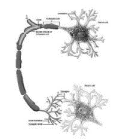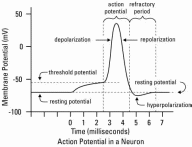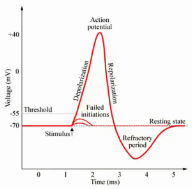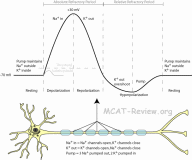Арсланова_Г_А_и_др_Essential_English_for_Biology_Students (1). Kazan federal university
 Скачать 7.01 Mb. Скачать 7.01 Mb.
|
Text 5.2. Setting up a nerve impulse ■ Essential targets: By the end of this text you should be able to: explain how a resting potential is maintained explain how an action potential is generated. Pre-reading ■ Discuss these questions with your partner. Then compare your ideas with the information given in the text. What do you know about the nature of nerve impulses? Why are nerve impulses important for humans? ■ Read the following text and make your essential assignments: Investigating nerve impulses N  erves convey information rapidly from one part of the body to another, enabling animals to respond quickly to changes in their external and internal environments. The information is carried in the form of electrical signals called nerve impulses. Most of our understanding of the nature of nerve impulses comes from work done on giant axons of squids. These are the nerve fibres responsible for the rapid escape movements of squids. Their large diameter (up to 1 mm) makes it possible to measure the electrical activity in a giant axon when it is at rest and when it is conveying a nerve impulse. A fine glass microelectrode is inserted inside an axon, and the voltage (potential difference; p.d.) between it and a reference electrode on the surface of the axon can be displayed on a cathode ray oscilloscope. By convention, the potential difference of the inside of the cell is always measured relative to that on the outside, so that the outside potential is taken as zero. Resting potential A resting neurone is so called because it does not convey a nerve impulse, not because it is inactive. On the contrary, a resting neurone expends much energy in maintaining a potential difference across its membrane. This is called the resting potential and measures about -70 millivolts. During the resting potential, the inside of the neurone is negative relative to the outside because of an unequal distribution of charged ions. On the outside, sodium ions (Na+), chloride ions (Cl-), and calcium ions Ca2+) are present in higher concentrations than inside the cell. By contrast, the inside of the cell has a higher concentration of potassium ions (K+) and organic anions (negative ions). This unequal distribution of ions results from a combination of active transport and diffusion of sodium and potassium ions across the cell membrane, and the inability of large organic anions to pass out of the cell. A sodium-potassium pump actively transports sodium ions out of the neurone and potassium ions in. For every three sodium ions pumped out, only two potassium ions are pumped inwards. On its own, this would result in only a slight potential difference across the membrane. However, this difference is amplified by the membrane being about 50 times more permeable to potassium ions than to sodium ions. Potassium ions are able to diffuse freely back out of the cell down their concentration gradient, but the sodium ions diffuse back into the cell only very slowly. This creates a negative electrical charge inside compared with outside. Without active transport, an equilibrium would eventually be reached and there would be no potential difference across the membrane. A  ction potential A nerve impulse occurs when the resting potential across the membrane of a neurone has a sufficiently high stimulus. A stimulus is any disturbance in the external or internal environment which changes the potential difference across a membrane. The stimulus may be chemical, mechanical, thermal, or electrical, or it may be a change in light intensity. The recording on the cathode ray oscilloscope shows the effects of a stimulus on a giant axon. When the stimulus is applied, the axon becomes depolarised; that is, the inside becomes temporarily less negative. If the stimulus is strong enough (if it exceeds the threshold level), an action potential occurs. There is a complete reversal of the charge across the nerve cell: the interior becomes positively charged relative to the outside. Typically, the action potential reaches a peak of about +35 millivolts. The potential difference then drops back down, undershoots the resting potential and finally returns to it. The return of the potential difference towards the resting potential is called repolarisation. The entire action potential takes about 7 milliseconds. Although this example refers specifically to a giant axon, its general features apply to all animal neurones. Ion channels and action potentials The action potential results from the changes in the permeability of cell membranes to ions. At rest, the membrane permeability of a nerve fibre is thought to depend on ion channels through which specific ions can move. An ion channel consists of a protein molecule spanning the membrane, with a pore through the centre. Sodium ions move through one type of channel and potassium ions through another. There are many more of these ion channels for potassium than for sodium, therefore at rest the membrane permeability to potassium ions is much greater than that to sodium ions. During an action potential, special ion channels control ion movements across the membrane. These channels are believed to have voltage-sensitive gates that open and close in response to voltage changes, and are therefore called voltage-gated ion channels. D  uring the resting potential, the voltage-gated sodium and potassium ion channels are closed. When a stimulus is applied, sodium ion channels open rapidly, sodium ions move in, and the inside becomes more positive. If the stimulus reaches the threshold level, an action potential occurs. When the action potential reaches its peak, the sodium ion channels close slowly and potassium ion channels open slowly. Sodium ions stop moving into the cell but potassium ions diffuse more rapidly out. These changes cause the potential difference to drop. When the membrane returns to its resting potential, potassium ion channels close, but because they do this slowly, the potential dips below the resting level. Finally, when the potassium ion channels are closed, the membrane returns to its resting condition. So far, we have examined how an action potential is generated at the point of stimulation. However, this is only the first step in the propagation of a nerve impulse along a neurone. These localised action potentials are converted into nerve impulses which transmit information from one part of a neurone to another neurone or to an effector such as a muscle or a gland. Action potentials obey the all-or-none law. This means that no matter how strong the stimulus, the size of an action potential is always the same. Therefore, information about the strength of a stimulus is carried along a nerve fibre not as variations in the size of nerve impulses, but by changes in their frequency. The next spread discusses these points more fully. ■ Glossary of essential terms for you to know
■ Your Essential Assignments. I. Quick check What are the main factors that determine the resting potential of a neurone? II. Using monolingual English dictionary write down what the words below mean: To insert, surface, to expend, charged, to amplify, to exceed. III. Match the words in the left column with the definitions in the right:
IV. Match words in A with words in B to form word combinations. Make up sentences with them.
V. Answer the following questions. Use all information given before: Why are voltage-gated ion channels called so? What the function of a sodium-potassium pump is? What does the membrane permeability of a nerve fibre depend on? What does an ion channel consist of? What does the all-or-none law mean? VI. Translate into English using all the active possible: Внутреннее пространство нейрона заряжено отрицательно относительно внешнего в связи с неравномерным распределением заряженных ионов. Величина потенциала действия не зависит от раздражителя. Животные могут быстро реагировать на изменения в окружающей среде в связи со способностью нервных волокон быстро передавать информацию. Нервный импульс – это информация, которая передаётся в форме электрических сигналов. Возникновение нервного импульса связано с достаточно сильным раздражителем. VII. Find English equivalents to the following word combinations and make up sentences with them:
VIII. Read and translate the short text without any dictionary Fact of life: Puffer fish produce a highly potent neurotoxin called tetrodotoxin. This selectively blocks the entry of sodium ions into nerve and muscle cells during an action potential, preventing the generation of nerve impulses and muscle contractions. IX. State whether the voltage-gated potassium ion channels and the voltage-gated sodium ion channels in a neurone membrane are open or closed: during the resting phase during the depolarisation phase of the action potential in the repolarisation phase during the undershoot. X. Suggest why depolarisation is not a good word for describing what happens during the transmission of an action potential. XI. Explain how resting potential and action potential are connected with each other. |
